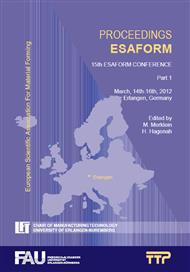p.89
p.95
p.101
p.107
p.113
p.119
p.125
p.131
p.137
Methodology to Produce Locally Heat-Treated EN AW-5182 Aluminum Alloy Sheet Metal Parts
Abstract:
Compared to steel, aluminum has a reduced formability. The consequence is that the drawability of aluminum needs to be extended. This can be achieved by a material recovery that takes place near the zones in which a material failure is initiated during deep drawing. In the considered process, first the aluminum component will be preformed to a specific stress state. In the second step, it will be partial heat treated, before the component is getting finished. Based on the selective intermediate introduction of heat, the material flow of the pre-drawn part is influenced in such a manner that the most highly stressed zones are subjected to further reduction in sheet thickness. This is possible by sacrificing material out of zones near the crack. These areas are referred to below as “sacrificial zones”. They depend on the position of the critical region as a result of the material pre-strain. In these regions, the temperature can be varied. This paper focuses on the development of a methodology to determine a layout of intermediate heat treatment of preformed aluminum sheet metal components. In order to determine such a layout, a principal part must be designed on which the methodology can be reviewed.
Info:
Periodical:
Pages:
113-118
Citation:
Online since:
February 2012
Price:
Сopyright:
© 2012 Trans Tech Publications Ltd. All Rights Reserved
Share:
Citation:


